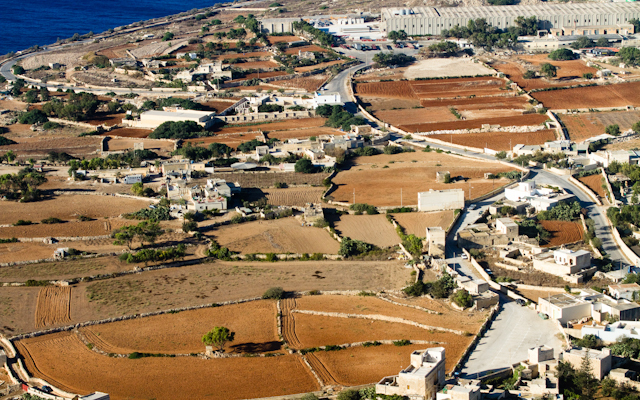Maltarapport 5

Från luften är det lätt att hitta fågelfångstställen, för den som kan läsa terrängen: här på bilden syns några ... Bilden tagen strax innan landningen, 21.9.2011. Foto: Håkan Eklund.
Ja, jag vet. Dessa långrandiga Maltabloggar är inte precis underhållande och roliga, men jag vill ändå få detta dokumenterat ("first hand"). Alltid finns det någon som förstår hur viktigt det är att alla länder som delar på samma avifauna skulle samarbeta och hålla sig till samma regler. Det är ju meningslöst att skydda faglar och habitat i Norden om de sedan under flyttningen skjuts ihjäl/fångas i fällor i andra medlemsländer. Just for fun! Det handlar ju om vårt gemensamma naturarv.
Idag hade jag en lång diskussion med chefen for BirdLife Malta (Paul Debono) som berättade om en liten framgång, i allt det till synes så hopplösa när myndigheter och politiker väljer att inte låtsas om att något är fel.
Han berättade om ett mångårigt projekt där de flygfotograferat alla fågelfångstområden (2000 +, som är stora som tennisplaner) på de båda öarna, kollat upp alla ställen i terrängen och försett alla fångstområden med exakta koordinater. Dessutom har de massor av vidomaterial och fotografier bifogat till rapporten som skickades till EU-byråkraterna i Bryssel, som resluterade i det som kan läsas nedan = ett litet jippiiiiii. För första gången i Maltas historia har landets regering inte "öppnat" fångstäsongen ... Under decenniernas gång har miljoner och åter miljoner finkar, trastar och andra smaåfåglar och vadare fångats här på Malta!
Detta betyder ju inte att alla kommer att lyda, men fångstområden är betydligt lättare att övervaka än illegal jakt, så det kommer att bli en jobbig höst för många ...
Här ett färskt pressmeddelande: http://www.birdlifemalta.org/view.aspx?id=336
Så här skrev BLM på sin webbplats i augusti 2011:
Autumn trapping postponed
The government yesterday did not declare an autumn trapping season, as it was previously expected to do.
The Government's decision comes after the European Commission last June challenged Malta's autumn trapping season through a Letter of Formal Notice which started infringement proceedings against Malta.
The Commission took this action as trapping is not permitted under the EU Birds Directive and can only take place under a derogation. As exemptions to clauses in EU law, derogations can only be applied by member states in exceptional circumstances and subject to strict specific conditions.
The government yesterday acknowledged that further information and assessment is needed before any future trapping season can be recommended. The government therefore announced a hunting season under similar conditions to last year, but no trapping season will be opened before an informed recommendation is made by the Ornis Committee.
“The government has acted responsibly by not opening a season until the necessary justification is at hand. This will however take time and it is therefore highly unlikely that any trapping season could be opened this year.” stated Nicholas Barbara, BirdLife Malta Conservation and Policy Officer and Ornis Committee member.
To identify this information and assessment government last Friday asked the Ornis Committee to further study the trapping derogation for Turtle Dove, Quail, Golden Plover and Song Thrush, which has been applied since Malta joined the EU in 2004.
“This shows that there is currently not enough data to support Malta's application of a trapping derogation or justification of previous trapping derogations. It is going to be very difficult to prove that Malta's circumstances and conditions satisfy those of the Birds Directive.” concluded Nicholas Barbara.
On joining the EU Malta agreed to phase out finch trapping to bring national legislation in line with the Birds Directive. This period ended in December 2008 and since then no finch trapping season has opened, however government has continued to permit the yearly trapping of Turtle Dove, Quail, Golden Plover and Song Thrush – a move now challenged by the European Commission.
______________________________________________________________________
För att förstå vad fågelfångst handlar om, har jag klistrat in den informationen här nedan (och detta är inte för att fånga fåglar till mat, utan för att hålla i burar, sälja som burfåglar):
Trapping in Malta is mainly carried out using clap nets. This method uses – two large nets which are placed parallel to each other on the ground and swing shut towards each other when activated. In preparation for the use of clap nets, trappers remove all vegetation in the trapping area and often dump soil or gravel to create a level surface where the nets can be spread. A number of live decoy birds are also placed around the trapping site - either kept in tiny cages or tied directly to the ground by a harness. Species trapped using this method include Greenfinch, Goldfinch, Hawfinch, Chaffinch, Serin, Linnet, Siskin, Turtle Dove, Golden Plover and Song Thrush. This type of trapping site is the one most frequently encountered in the Maltese countryside.
Another type of net used is a vertical net spread over a tall crop, such as corn, with three sides dangling to the ground and the fourth tied up like a curtain.
This net is used to catch Common Quail, which seek cover in the crops after arriving in Malta at night – they are again attracted to the area by a large number of live decoys or electronic lures. In the morning the net is closed completely and a dog is pushed under the net to flush the trapped quails into a corner where they can be removed by the trapper.
Cage traps are often used to trap Turtle and Collared Doves (a protected species), although they are also effective in target a wide range of other species.
Cage traps consist of a large central cage in which live decoy birds, food and water are kept, and separate cages into which wild birds can enter. Wild birds are attracted by the live decoys and enter the cage through small holes to join the decoys. These cages work like fish pots – once the bird goes in it can’t get out.
Decoy birds are normally used by trappers to lure wild birds into a trap; however tape lures are also being illegally used. A tape lure repeating the calls of wild birds is a very effective method of attracting birds to a trapping site as it can be left to run repeatedly for all night.
All the above described methods are illegal under the Birds Directive.


